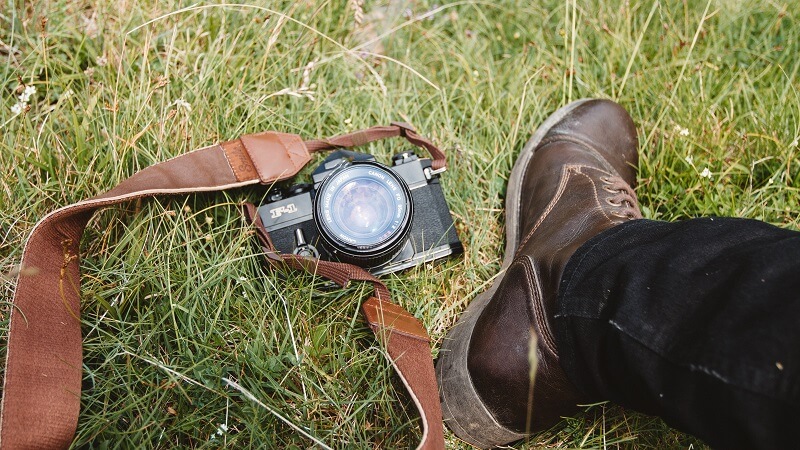
How To Keep Your Camera Strap From Fading
Within the first few moments of embarking on a photographic journey, your camera strap not only becomes a part of your gear but also an

In the realm of photography, every detail matters, and this includes the humble yet essential leather camera strap.
Often overlooked, this critical accessory is key to both the safety and the aesthetic of your photographic equipment.
This blog embarks on a journey to compare leather camera straps with those made from regular materials, showcasing their distinct advantages and potential drawbacks.
The role of camera straps transcends mere functionality. They are the unsung heroes that provide security and comfort during photography sessions.
Ensuring that your camera is always at hand, these straps are vital for capturing those spontaneous, fleeting moments that define the art of photography.
They not only prevent accidental drops but also reduce physical strain, allowing photographers to focus on their craft rather than on the discomfort of carrying their equipment.
Leather, a material celebrated for its strength and graceful aging, offers an unparalleled blend of style and endurance in camera straps.
This section delves into the myriad benefits and considerations of choosing a leather camera strap.
Straps made from materials such as nylon, polyester, or cotton offer a practical and versatile alternative to leather.
Each material brings its own set of benefits, catering to photographers who prioritize functionality and budget.
The choice between a leather camera strap and a regular material strap often hinges on the specific requirements of the photographer and the shooting environment.
For instance, photojournalists or adventure photographers might prefer the durability and ease of maintenance of nylon straps, while studio photographers or those attending formal events might opt for the elegance of leather.
While leather camera straps typically come with a higher price tag, they offer a unique combination of durability and style.
On the other hand, regular material straps are widely available at various price points, making them a more budget-friendly option for many photographers.
Gathering feedback from fellow photographers is invaluable in making an informed decision between a leather camera strap and a regular material strap.
Online photography communities, product review sites, and personal networks can provide diverse perspectives on the practicality, comfort, and longevity of each type of strap.
In the end, the choice between a leather camera strap and one made from regular materials is a personal one, influenced by factors such as budget, intended use, and personal style.
Leather straps offer an unmatched combination of durability and elegance, making them a favored choice for photographers who value longevity and aesthetics.
Regular material straps, meanwhile, appeal to those seeking practicality, ease of maintenance, and affordability.
Whichever option you choose, ensure it aligns with your needs and complements your photographic journey, adding both functionality and style to your shooting experience.
Q1: How do I choose between a leather and a regular material camera strap for different types of photography?
A1: Consider the environment and your photography style. For outdoor, rugged conditions, regular materials like nylon are preferable for their durability and ease of maintenance. For studio or portrait photography where style is key, a leather strap adds a touch of elegance.
Q2: Can leather camera straps cause allergies or skin irritation?
A2: While rare, some individuals may have sensitivities to leather or the chemicals used in its tanning process. If you have sensitive skin or known allergies, you might want to test a leather strap for a short period before committing to it.
Q3: Are there eco-friendly options for camera straps?
A3: Yes, there are eco-friendly options available for both leather and regular material straps. Look for straps made from sustainable materials, like recycled fabrics or ethically sourced leather, to minimize environmental impact.
Q4: How can I extend the life of my camera strap, regardless of its material?
A4: Regular cleaning and proper storage are key. For leather, use a suitable leather conditioner to prevent drying and cracking. For synthetic materials, avoid exposure to harsh chemicals and extreme temperatures. Store your strap in a dry, cool place when not in use.
Q5: Is it possible to get a custom-made camera strap, and what are the benefits?
A5: Yes, custom-made camera straps are available, and they offer the benefit of personalized fit, style, and functionality. You can choose the material, length, width, and even add personal touches like monograms. Custom straps can enhance comfort and reflect your personal style.


Within the first few moments of embarking on a photographic journey, your camera strap not only becomes a part of your gear but also an

The moment you sling your camera strap over your shoulder, it becomes more than an accessory; it’s your camera’s lifeline, a bridge between you and

When it comes to photography gear, the camera strap might not be the first thing that springs to mind. Yet, this humble accessory is the

Your camera strap might seem like a small part of your photography gear, but it’s the lifeline that keeps your precious camera from taking a

Within the first few moments of embarking on a photographic journey, your camera strap not only becomes a part of your gear but also an

The moment you sling your camera strap over your shoulder, it becomes more than an accessory; it’s your camera’s lifeline, a bridge between you and

When it comes to photography gear, the camera strap might not be the first thing that springs to mind. Yet, this humble accessory is the

Your camera strap might seem like a small part of your photography gear, but it’s the lifeline that keeps your precious camera from taking a
Copyright © 2024 photocamerastrap. All Rights Reserved.